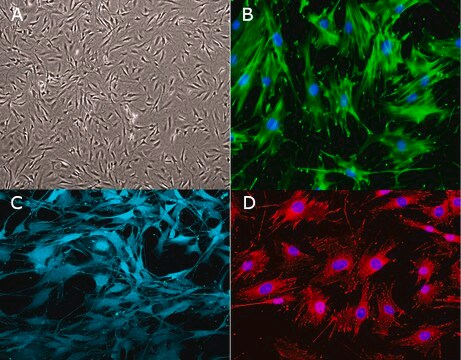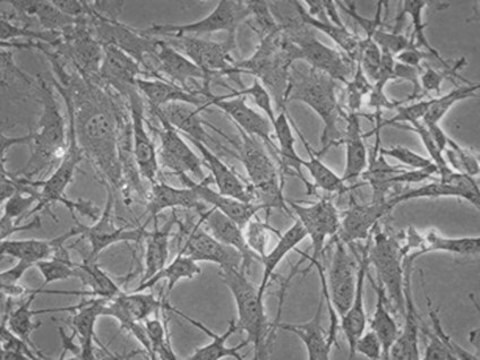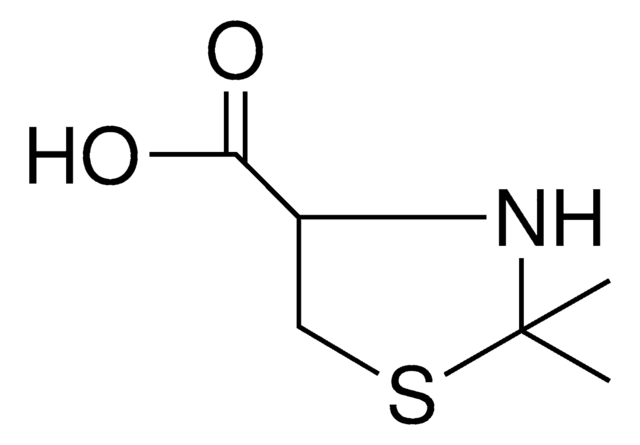SCC495
Mouse OP9-DL4 Notch Ligand Cell Line (-GFP)
Sinônimo(s):
DL4 cell line, Delta-like 4 cell line, Notch ligand cell line, OP9-DL4, OP9-DL4 cell line
Faça loginpara ver os preços organizacionais e de contrato
About This Item
Código UNSPSC:
41106514
NACRES:
NA.81
Produtos recomendados
fonte biológica
mouse
Nível de qualidade
embalagem
vial of ≥1X10⁶ cells/vial vial
fabricante/nome comercial
Millipore
técnica(s)
cell culture | mammalian: suitable
Condições de expedição
liquid nitrogen
temperatura de armazenamento
−196°C
Aplicação
- Each vial contains > 1X106 viable cells.
- Cells are tested negative for infectious diseases by a Mouse Essential CLEAR Panel by Charles River Animal Diagnostic Services.
- Cells are verified to be of mouse origin and negative for interspecies contamination from human, rat, Chinese hamster, Golden Syrian hamster, and nonhuman primate (NHP) as assessed by a Contamination Clear panel by Charles River Animal Diagnostic Services
- Cells are negative for mycoplasma contamination.
Características e benefícios
OP9-DL4 (-GFP) is a stable bone marrow derived stromal cell line expressing the Notch ligand-Delta like 4 (DL4) with the GFP coding region removed for stem cell differentiation applications.
Descrição-alvo
OP9-DL4 is a stable bone marrow derived stromal cell line expressing the Notch ligand- Delta like 4 (DL4) ectopically.
Notch signaling controls multiple cell-fate decisions. Four Notch receptors (Notch 1- Notch 4) have been identified in mammals. These receptors interact with Jagged or Delta-like (DL) family members of Notch ligands. This is followed by cleavage of the intracellular domain of Notch and its subsequent translocation into the nucleus, where it binds with transcription factors and activates transcription of various downstream target genes. Notch signaling is essential in early T- cell lineage commitments. Bone marrow progenitor cells expressing constitutively-active Notch develop into CD4 and CD8 double positive T cells rather than B cells. They also play an important role in development of CD4+ and CD8+ single positive cells from double positive precursor thymocytes, in addition to development of T-cells with αα+ TCRs. Of the 4 Notch receptors, Notch1 (N1) receptor signaling has been shown to be sufficient for T cell development. The delta like ligands are physiologically relevant N1 ligands. DL1 interacts with both N1 and Notch 2 (N2) to induce T- cell lineage commitment. However, DL4 interacts specifically only with N1 and supports T cell commitment and maturation both in vitro and in vivo. Moreover, results from previous binding studies show that binding between DL1 and N1 is weak as opposed to the stronger binding between DL4 and N1. Of the DL1 and DL4 delta like ligands, DL4 exhibits greater capacity to activate the Notch pathway in hematopoietic progenitor cells.
SCC495 OP9-DL4 Cell line has had the GFP coding region removed from the original pMiGR plasmid, resulting in no GFP expression for this cell line.
Source
OP9-DL4 cells were genetically modified from OP9 stromal cells derived from mouse bone marrow.
References
1. Immunity 2002, 17(6): 749-756.
2. J Orthop Sci. 2005, 10(6): 589-594.
3. Curr Opin Immunol. 2007, 19(2): 163-168.
4. Cold Spring Harb Protoc. 2009, 2009(2): pdb.prot5156.
Notch signaling controls multiple cell-fate decisions. Four Notch receptors (Notch 1- Notch 4) have been identified in mammals. These receptors interact with Jagged or Delta-like (DL) family members of Notch ligands. This is followed by cleavage of the intracellular domain of Notch and its subsequent translocation into the nucleus, where it binds with transcription factors and activates transcription of various downstream target genes. Notch signaling is essential in early T- cell lineage commitments. Bone marrow progenitor cells expressing constitutively-active Notch develop into CD4 and CD8 double positive T cells rather than B cells. They also play an important role in development of CD4+ and CD8+ single positive cells from double positive precursor thymocytes, in addition to development of T-cells with αα+ TCRs. Of the 4 Notch receptors, Notch1 (N1) receptor signaling has been shown to be sufficient for T cell development. The delta like ligands are physiologically relevant N1 ligands. DL1 interacts with both N1 and Notch 2 (N2) to induce T- cell lineage commitment. However, DL4 interacts specifically only with N1 and supports T cell commitment and maturation both in vitro and in vivo. Moreover, results from previous binding studies show that binding between DL1 and N1 is weak as opposed to the stronger binding between DL4 and N1. Of the DL1 and DL4 delta like ligands, DL4 exhibits greater capacity to activate the Notch pathway in hematopoietic progenitor cells.
SCC495 OP9-DL4 Cell line has had the GFP coding region removed from the original pMiGR plasmid, resulting in no GFP expression for this cell line.
Source
OP9-DL4 cells were genetically modified from OP9 stromal cells derived from mouse bone marrow.
References
1. Immunity 2002, 17(6): 749-756.
2. J Orthop Sci. 2005, 10(6): 589-594.
3. Curr Opin Immunol. 2007, 19(2): 163-168.
4. Cold Spring Harb Protoc. 2009, 2009(2): pdb.prot5156.
Armazenamento e estabilidade
OP9-DL4 (-GFP) cells should be stored in liquid nitrogen. The cells can be cultured for at least 10 passages without significantly affecting cell marker expression and function.
Outras notas
This product is intended for sale and sold solely to academic institutions for internal academic research use per the terms of the “Academic Use Agreement” as detailed in the product documentation. For information regarding any other use, please contact l
Exoneração de responsabilidade
Unless otherwise stated in our catalog or other company documentation accompanying the product(s), our products are intended for research use only and are not to be used for any other purpose, which includes but is not limited to, unauthorized commercial uses, in vitro diagnostic uses, ex vivo or in vivo therapeutic uses or any type of consumption or application to humans or animals.
Código de classe de armazenamento
10 - Combustible liquids
Classe de risco de água (WGK)
WGK 3
Ponto de fulgor (°F)
Not applicable
Ponto de fulgor (°C)
Not applicable
Certificados de análise (COA)
Busque Certificados de análise (COA) digitando o Número do Lote do produto. Os números de lote e remessa podem ser encontrados no rótulo de um produto após a palavra “Lot” ou “Batch”.
Já possui este produto?
Encontre a documentação dos produtos que você adquiriu recentemente na biblioteca de documentos.
Nossa equipe de cientistas tem experiência em todas as áreas de pesquisa, incluindo Life Sciences, ciência de materiais, síntese química, cromatografia, química analítica e muitas outras.
Entre em contato com a assistência técnica








